Related Research Articles
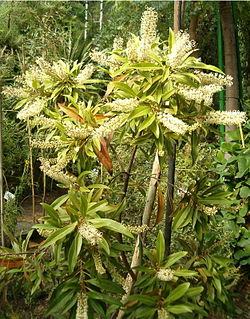
Buckinghamia is a genus of only two known species of trees, belonging to the plant family Proteaceae. They are endemic to the rainforests of the wet tropics region of north eastern Queensland, Australia. The ivory curl flower, B. celsissima, is the well known, popular and widely cultivated species in gardens and parks, in eastern and southern mainland Australia, and additionally as street trees north from about Brisbane. The second species, B. ferruginiflora, was only recently described in 1988.
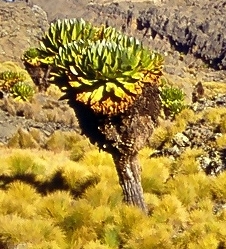
Dendrosenecio keniodendron or giant groundsel is a species of the genus Dendrosenecio of the large family Asteraceae and is one of the several species of giant groundsels endemic to the high altitudes of the Afrotropic, including Dendrosenecio johnstonii (Senecio battiscombei) occurring on Mount Kilimanjaro, Mount Kenya, and the Aberdare Mountains, Dendrosenecio keniensis occurring the lower alpine zone of Mount Kenya and D. keniodendron occurring in higher and drier sites on Mount Kenya. The giant rosette plants, sometimes 6 metres (20 ft) tall, often grow in even-sized stands, with different understory communities under different-aged stands.

Smilax aspera, with common names common smilax, rough bindweed, sarsaparille, and Mediterranean smilax, is a species of flowering vine in the greenbriar family.
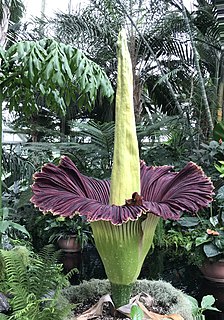
Amorphophallus titanum, the titan arum, is a flowering plant with the largest unbranched inflorescence in the world. The titan arum's inflorescence is not as large as that of the talipot palm, Corypha umbraculifera, but the inflorescence of the talipot palm is branched rather than unbranched. The species is endemic to Sumatra.

Impatiens balfourii is a species of the genus Impatiens known by the common names Balfour's touch-me-not, Kashmir balsam, and poor man's orchid. It belongs to the family Balsaminaceae.

Lotus hirsutus, also known by the synonym Dorycnium hirsutum, common name: canary clover or hairy canary-clover, is a species of flowering plant in the legume family Fabaceae.

Lotus dorycnium, previously known by the synonym Dorycnium pentaphyllum, common names: prostrate Canary clover and badassi, is a herbaceous perennial plant belonging to the genus Lotus of the family Fabaceae.

Iberis umbellata, common name garden candytuft or globe candytuft, is a herbaceous annual flowering plant of the genus Iberis and the family Brassicaceae.

Crocosmia aurea, common name Falling Stars, Valentine Flower, or Montbretia, is a perennial flowering plant belonging to the family Iridaceae.
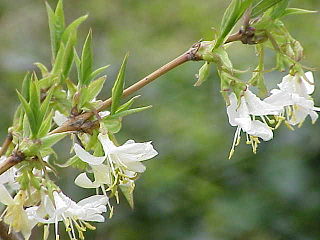
Lonicera fragrantissima is a species of flowering plant in the honeysuckle family known by the common names winter honeysuckle, fragrant honeysuckle, January jasmine, Chinese honeysuckle, kiss-me-at-the-gate, and sweet breath of spring. It is native to China and has been an introduced species to other parts of the world. It was brought to the attention of western gardeners by Scottish plant hunter Robert Fortune, who was plant hunting in China for the Royal Horticultural Society. Fortune introduced Lonicera fragrantissima to England in 1845, and a few years later it was introduced to the United States. In 1853 the editor of American gardening magazine The Horticulturist wrote that the previous year he had been sent a specimen from a plant that had been flowering in the gardens of Hatfield House, the Marquess of Salisbury's stately home in Hertfordshire. The first mention of a specimen for commercial sale in an American plant catalogue is in 1860.
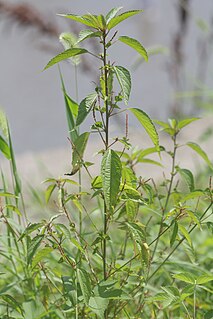
Acalypha australis, commonly known as Asian copperleaf, is a species of flowering plant in the family Euphorbiaceae native to eastern Asia.

Dysoxylum parasiticum, known as yellow mahogany, is a species of rainforest trees in the family Meliaceae. The specific epithet parasiticum is from the Latin meaning "parasitic", referring to the idea that the flowers are parasitic on another tree species.
Alangium kurzii is a tree in the family Cornaceae. It is named for the German naturalist Wilhelm Sulpiz Kurz.
Alchornea latifolia is a species of tree in the family Euphorbiaceae. It is native to Central America where its common names include aguacatillo, baconá and chote.
Pomatosace filicula is a species of flowering plant in the family Primulaceae, endemic to the Qinghai–Tibetan Plateau in China.
Ranunculus trivedii is a flowering plant in the buttercup family Ranunculaceae. It is one of the highest altitude flowering plants in the world.
Solms-laubachia is a high-altitude genus of perennial herbs in the family Brassicaceae. It is named for the German botanist Hermann zu Solms-Laubach.
Rhodolaena bakeriana is a tree in the family Sarcolaenaceae. It is endemic to Madagascar.
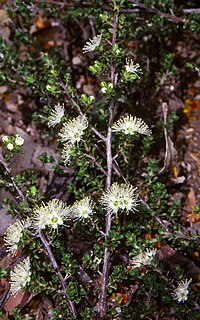
Kunzea badjaensis is a flowering plant in the myrtle family, Myrtaceae and is endemic to a small area of New South Wales. It is a shrub with egg-shaped leaves and clusters of white flowers near the end of the branches. It grows at high altitudes on the Southern Tablelands.
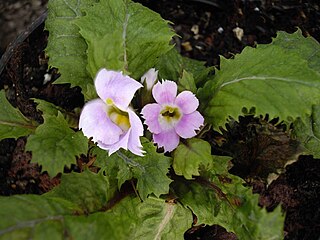
Primula bracteosa, the orange throated primrose, is a perennial species of primrose which is found on rocky crevices and of ravines at the altitudes of 2,300–2,700 metres (7,500–8,900 ft) in southern Xizhang, Bhutan, northeast India, Sikkim and Nepal.
References
- 1 2 "Solms-laubachia himalayensis". Tropicos . Missouri Botanical Garden . Retrieved 15 Sep 2016.
- 1 2 3 "Solms-laubachia himalayensis". Flora of Nepal. Royal Botanic Garden Edinburgh. 2014. Retrieved 15 Sep 2016.
- ↑ Young, Mark C. (ed.). Guinness Book of World Records 1997 . Guinness Publishing Ltd. pp. 42. ISBN 0-9652383-0-X.
| This Brassicales article is a stub. You can help Wikipedia by expanding it. |